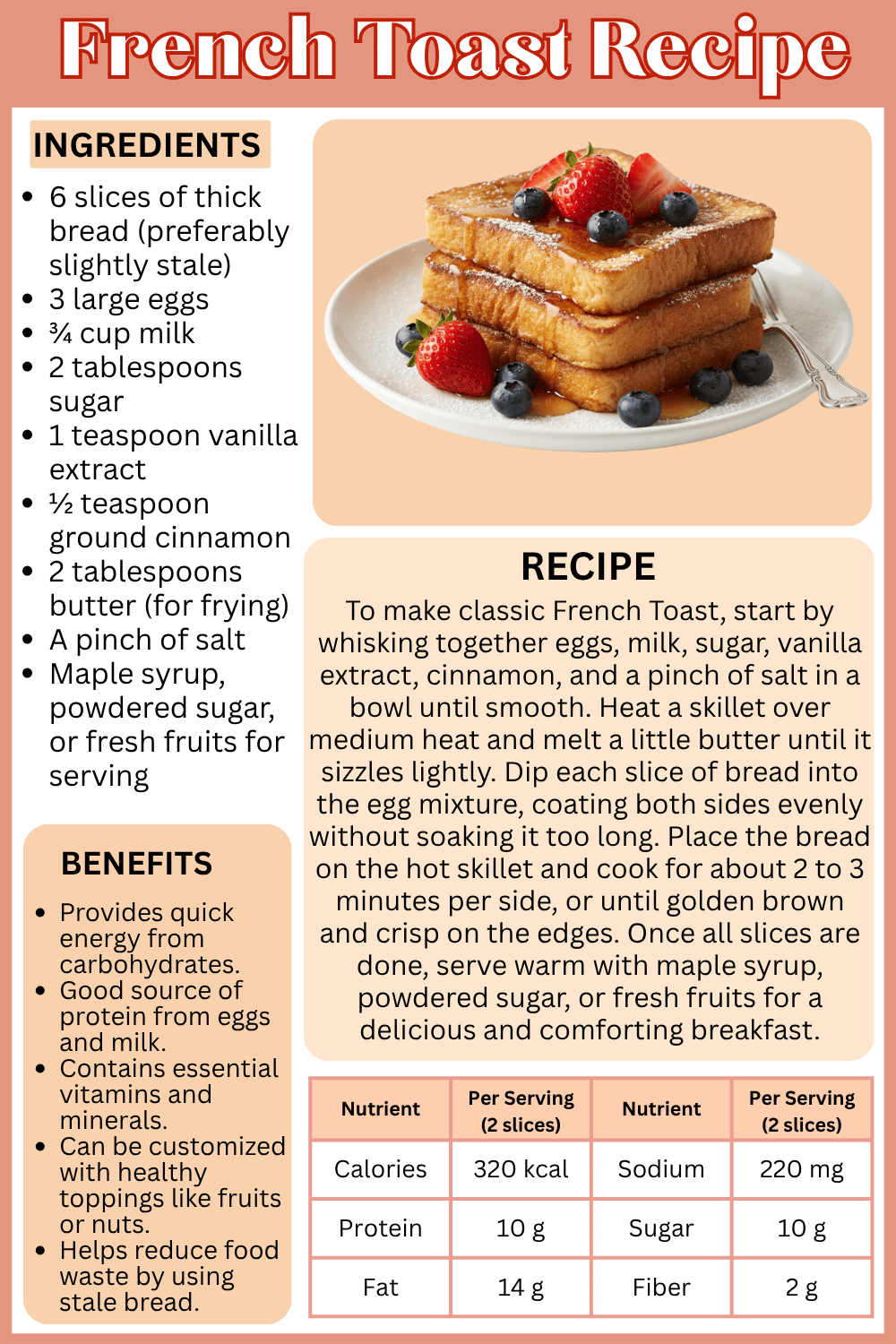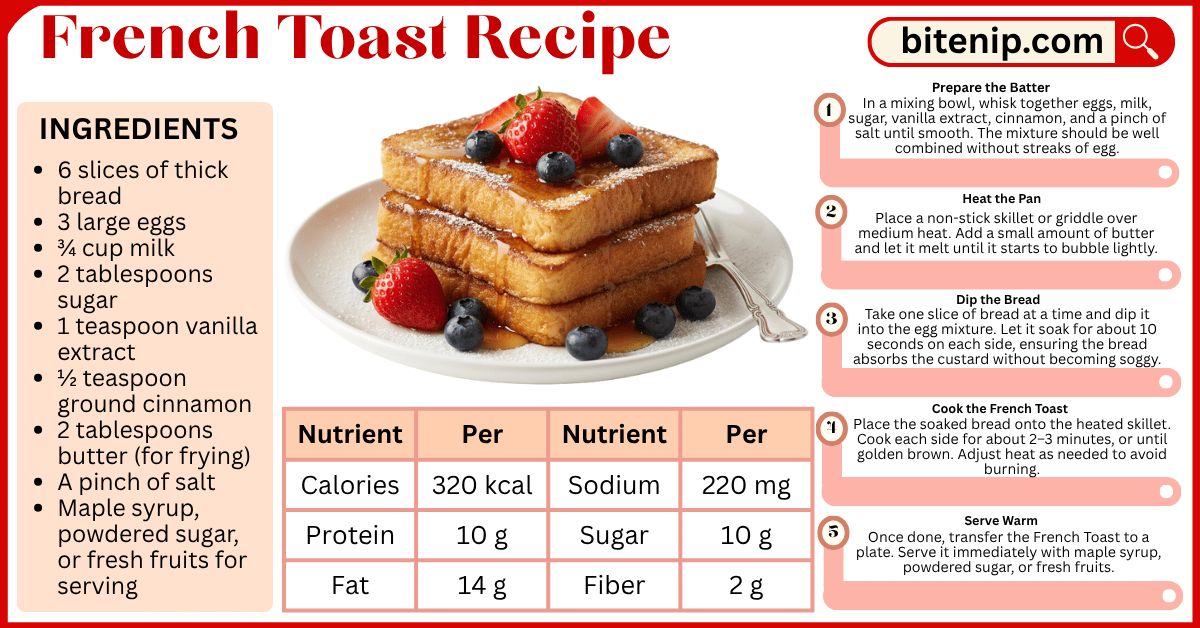French Toast is one of those comforting breakfast dishes that never goes out of style. It’s crispy on the outside, soft inside, and rich with the flavors of eggs, milk, and a touch of vanilla. Whether enjoyed with maple syrup, berries, or powdered sugar, this simple yet elegant recipe turns ordinary bread into something special. What makes French Toast so loved is its balance of texture and taste—it’s both satisfying and nostalgic.
Origin of French Toast
Although it’s called French Toast, the dish actually dates back to ancient Rome. Historical records show that Romans soaked bread in milk and eggs before frying it in oil or butter. In France, it’s known as “Pain Perdu,” which means “lost bread,” referring to the practice of using stale bread to avoid waste. Over time, this humble idea spread across Europe and later became a beloved breakfast in America, especially with added toppings like syrup, fruit, and whipped cream.
Ingredients of French Toast Recipe with Pictures
- Bread
he main ingredient that provides structure. Thick, slightly stale slices absorb the custard mixture well, creating a soft yet crisp texture when cooked.
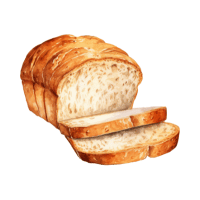
- Eggs
They bind the ingredients together and add richness to the batter. Eggs also help the bread form a golden crust.

- Milk
Adds moisture and helps create the custard base for soaking the bread. It balances the richness of the eggs.
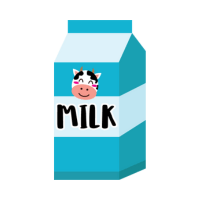
- Sugar
Sweetens the mixture slightly without overpowering it.
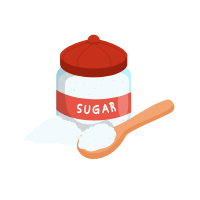
- Vanilla Extract
Adds warmth and a sweet aroma that enhances flavor.

- Cinnamon
Brings a cozy, spicy note to the dish, making it more aromatic.
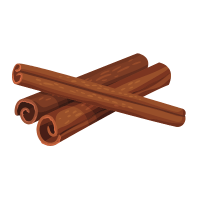
- Butter
Used for frying, giving French Toast its signature golden color and crispy edges.

- Salt
A small pinch enhances all the other flavors.
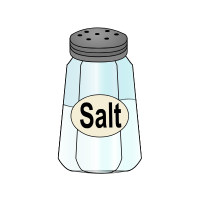
Ingredients with Quantities
| Ingredient | Quantity |
|---|---|
| Bread slices (thick) | 6 slices |
| Eggs | 3 large |
| Milk | ¾ cup |
| Sugar | 2 tablespoons |
| Vanilla extract | 1 teaspoon |
| Ground cinnamon | ½ teaspoon |
| Butter (for frying) | 2 tablespoons |
| Salt | A pinch |
Step by Step French Toast Recipe
Step 1: Prepare the Batter
In a mixing bowl, whisk together eggs, milk, sugar, vanilla extract, cinnamon, and a pinch of salt until smooth. The mixture should be well combined without streaks of egg.
Step 2: Heat the Pan
Place a non-stick skillet or griddle over medium heat. Add a small amount of butter and let it melt until it starts to bubble lightly.
Step 3: Dip the Bread
Take one slice of bread at a time and dip it into the egg mixture. Let it soak for about 10 seconds on each side, ensuring the bread absorbs the custard without becoming soggy.
Step 4: Cook the French Toast
Place the soaked bread onto the heated skillet. Cook each side for about 2–3 minutes, or until golden brown. Adjust heat as needed to avoid burning.
Step 5: Serve Warm
Once done, transfer the French Toast to a plate. Serve it immediately with maple syrup, powdered sugar, or fresh fruits.

Common Mistakes to Avoid
Using fresh bread: Fresh bread tends to fall apart when soaked. Slightly stale bread works better because it holds up and absorbs the mixture evenly.
Over-soaking the bread: Leaving bread in the egg mixture too long can make it mushy inside. A quick soak on both sides is enough.
Cooking on high heat: High heat causes the toast to brown too quickly on the outside while remaining undercooked inside. Medium heat ensures even cooking.
Skipping the salt: Even a small pinch of salt helps balance sweetness and enhances flavor. Never skip it.
Tips for Perfect French Toast Recipe
Use brioche or challah: These types of bread are rich and soft, giving you a creamy inside and crisp edges.
Add flavor to the batter: A touch of nutmeg or orange zest can make your French Toast unique and aromatic.
Keep it warm: If making multiple slices, keep cooked pieces in a low oven (about 200°F or 95°C) until ready to serve.
Use clarified butter: It prevents burning and helps achieve an even golden crust.
Variations of French Toast Recipe
Stuffed French Toast: Fill slices with cream cheese or fruit preserves before dipping in the batter for a dessert-style twist.
Savory French Toast: Skip the sugar and vanilla, and add herbs and cheese instead. It pairs beautifully with eggs or bacon.
Baked French Toast Casserole: Layer bread pieces in a dish, pour over the custard, and bake until golden. Perfect for feeding a crowd.
Vegan French Toast: Replace eggs with mashed bananas or plant-based milk mixed with cornstarch for an animal-free version.
Serving Suggestions
French Toast is best served warm with toppings like maple syrup, honey, whipped cream, or seasonal fruits. You can also dust it with powdered sugar or add a side of crispy bacon for a balance of sweet and savory flavors. For an indulgent breakfast, serve it with caramelized bananas or a drizzle of chocolate sauce.
Nutritional Information
| Nutrient | Per Serving (2 slices) |
|---|---|
| Calories | 320 kcal |
| Protein | 10 g |
| Fat | 14 g |
| Carbohydrates | 36 g |
| Sugar | 10 g |
| Fiber | 2 g |
| Sodium | 220 mg |
Why People Love This Dish ?
People love French Toast because it feels indulgent yet simple. It’s quick to prepare, adaptable, and can be enjoyed for breakfast, brunch, or even dessert. The mix of soft bread with a hint of sweetness and crisp buttery edges makes it universally comforting. It also brings a sense of nostalgia, reminding many of childhood weekends or family breakfasts.
Benefits of French Toast Recipe
1. Provides a Good Energy Boost
French Toast is rich in carbohydrates from the bread, which gives your body quick energy to start the day. It’s a great breakfast option when you need something filling and satisfying.
2. Good Source of Protein
The eggs and milk in the batter supply protein, which helps repair body tissues and supports muscle growth. Adding toppings like nuts or yogurt can increase the protein content even more.
3. Contains Essential Nutrients
French Toast includes vitamins and minerals such as calcium, iron, and vitamin D from milk and eggs. These nutrients are important for healthy bones, stronger immunity, and better overall health.
4. Versatile and Easy to Customize
You can make it sweet or savory, depending on your preference. Adding fruits like berries or bananas increases fiber and antioxidants, while savory versions with herbs or cheese add more variety.
5. Reduces Food Waste
Traditionally made with stale bread, French Toast helps you use leftovers efficiently, making it both budget-friendly and environmentally conscious.
6. Comforting and Satisfying
Its warm, soft interior and crisp edges make it emotionally comforting. It’s a dish that feels indulgent but still simple and homely, which explains why it’s a favorite in many households.
Disadvantages of French Toast Recipe
1. High in Calories
Depending on how it’s prepared, French Toast can be calorie-dense, especially when fried in butter and topped with syrup, whipped cream, or powdered sugar. Eating it frequently without moderation can lead to weight gain.
2. Contains Saturated Fats
Butter, cream, and certain types of bread add saturated fat, which can increase cholesterol levels if consumed in excess. Choosing healthier oils or using less butter can help reduce this risk.
3. Can Be High in Sugar
Adding too much sugar to the batter or using sugary toppings can make French Toast a less healthy choice. Excess sugar contributes to fatigue, weight gain, and dental problems.
4. Low Fiber Content (If Made with White Bread)
White bread lacks fiber, which is important for digestion and satiety. Using whole-grain or multigrain bread can improve its nutritional value.
5. Not Ideal for Daily Consumption
While delicious, French Toast is best enjoyed occasionally. Regular intake may add unnecessary calories and fats to your diet, especially if not balanced with other healthy meals.
FAQs
1. Can I use any bread for French Toast?
Yes, but thicker slices like brioche or challah work best.
2. Why is my French Toast soggy?
It’s likely because you soaked the bread too long or used too much milk in the mixture.
3. Can I make French Toast ahead of time?
Yes, reheat it in the oven or air fryer for a few minutes to restore crispiness.
4. Can I freeze French Toast?
Absolutely. Store cooled slices in an airtight bag and reheat when needed.
5. What’s the best milk to use?
Whole milk gives the richest flavor, but almond or oat milk also work well.
6. How do I make it crispier?
Use day-old bread and cook with clarified butter on medium heat.
7. Can I make it dairy-free?
Yes, substitute plant-based milk and cook in coconut oil or vegan butter.
8. Is French Toast healthy?
It can be, especially when made with whole-grain bread and fresh fruit instead of syrup.
9. What can I serve with French Toast?
Bacon, sausage, yogurt, or a side of berries all pair beautifully.
10. Can I add chocolate or nuts?
Yes, adding chocolate chips or crushed nuts gives it extra texture and flavor.
Conclusion
French Toast is a timeless recipe that’s both simple and satisfying. With just a few basic ingredients, you can turn plain bread into a delicious breakfast that feels special every time. By following these tips and avoiding common mistakes, you’ll achieve that perfect balance of crisp edges and soft, custardy centers. Whether you keep it classic or add your own twist, French Toast will always remain a comforting favorite.
